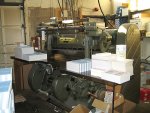Joseph Shaul
Member
- Messages
- 206
- Location
- Madison, WI
I'm helping out with a high school art program, and their guillotine shears is out of comission. It seems to be in okay shape, but the teacher noted that it ceased to cut properly only a few uses after being set up.
Since the shears in question are a lot neater and less wasteful than the bench shears they're currently using, I figure I'll take a crack at getting it up and running again. I'm guessing that some of the nuts and bolts used to clamp down the blade in need of replacement, and that a few of the bits aren't set in the right places. Does anyone have a link to a description of the correct way to set up a guillotine shears?
Since the shears in question are a lot neater and less wasteful than the bench shears they're currently using, I figure I'll take a crack at getting it up and running again. I'm guessing that some of the nuts and bolts used to clamp down the blade in need of replacement, and that a few of the bits aren't set in the right places. Does anyone have a link to a description of the correct way to set up a guillotine shears?



 Our materials are .064 - 16ga, .153 - 11pt & .25 (obviously, 1/4") Magnesium for acid etched printing plates
Our materials are .064 - 16ga, .153 - 11pt & .25 (obviously, 1/4") Magnesium for acid etched printing plates